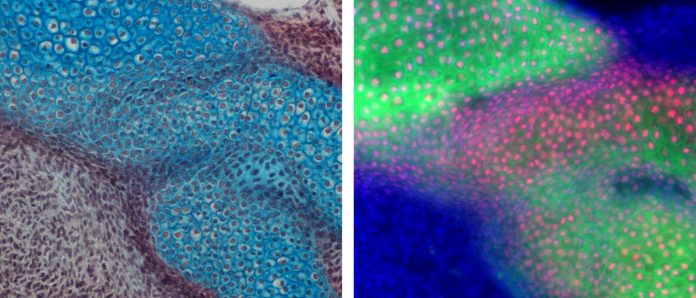Infant marsupials and monotremes use a connection between their ear and jaw bones shortly after birth to enable them to drink their mothers’ milk, new findings in eLife reveal.
This discovery by researchers at King’s College London, UK, provides new insights about early development in mammals, and may help scientists better understand how the bones of the middle ear and jaw evolved in mammals and their predecessors.
Marsupials such as opossums, and monotremes such as echidnas, are unusual types of mammals. Both types of animal are born at a very early stage in development, before many bones in the body have started to form. Opossums latch on to their mother’s nipple and stay there while they finish developing. Monotremes, which hatch from eggs, lap milk collected near their mother’s milk glands as they grow. But how they are able to drink the milk before their jaw joint is fully developed was previously unclear.
“Given the lack of a jaw joint in marsupials and monotremes at birth, scientists have previously suggested that the animals may use a connection between the middle ear bones and jaw bones to allow them to feed,” explains lead author Neal Anthwal, Research Associate at the Centre for Craniofacial & Regenerative Biology, at King’s College London’s Faculty of Dentistry, Oral & Craniofacial Sciences in the UK.
To find out if this is true, Anthwal and his colleagues compared the jaw bones in platypus, short-beaked echidnas, opossums and mice shortly after birth. Their work revealed that, soon after echidnas hatch, their middle ear bones and upper jaw fuse, eventually forming a joint that is similar to the jaws of mammal-like reptile fossils. The team found a similar connection in mouse embryos, but this disappears and the animals are born with functioning jaw joints.
Opossums, by contrast, use connective tissue between their middle ear bones and the base of their skull to create a temporary jaw joint that enables them to nurse shortly after birth. “This all shows that marsupials and monotremes have different strategies for coping with early birth,” Anthwal says.
The findings suggest that the connection between the ear and jaw dates back to an early mammal ancestor and persisted when mammals split into subgroups. Marsupials and monotremes continue to use these connections temporarily in early life. In other mammals, such as mice, these connections occur briefly as they develop in the womb but are replaced by a working jaw joint before birth.
“Our work provides novel insight into the evolution of mammals,” concludes senior author Abigail Tucker, Principal Investigator and Professor of Development & Evolution at the Centre for Craniofacial & Regenerative Biology, King’s College London. “In particular we highlight how structures can change function over evolutionary time but also during development, with the ear bones moving from feeding to hearing. The recent availability of monotreme tissue for molecular analysis, as showcased here, provides an amazing future opportunity to understand the biology of these weird and wonderful mammals, which we are keen to explore.”
###
Reference
The paper ‘Transient role of the middle ear as a lower jaw support across mammals’ can be freely accessed online at https:/
Media contacts
Emily Packer, Senior Press Officer
eLife
[email protected]
01223 855373
Laura Shepherd
Faculty Communications, King’s College London
[email protected]
07934 467529
About eLife
eLife is a non-profit organisation created by funders and led by researchers. Our mission is to accelerate discovery by operating a platform for research communication that encourages and recognises the most responsible behaviours. We work across three major areas: publishing, technology and research culture. We aim to publish work of the highest standards and importance in all areas of biology and medicine, including Developmental Biology and Evolutionary Biology, while exploring creative new ways to improve how research is assessed and published. We also invest in open-source technology innovation to modernise the infrastructure for science publishing and improve online tools for sharing, using and interacting with new results. eLife receives financial support and strategic guidance from the Howard Hughes Medical Institute, the Knut and Alice Wallenberg Foundation, the Max Planck Society and Wellcome. Learn more at https:/
To read the latest Developmental Biology research published in eLife, visit https:/
And for the latest in Evolutionary Biology, see https:/
About the Faculty of Dentistry, Oral & Craniofacial Sciences at King’s College London
King’s College London’s Faculty of Dentistry, Oral & Craniofacial Sciences is one of the foremost dental schools in the world. Recently ranked first in the world in dentistry by the QS World University Rankings 2020, the Faculty aims to maximise impact on health and wellbeing by integrating excellence across four areas:
Education / teaching
World-class science
Clinical approaches
Patient care
The Faculty’s mission is to understand disease, enhance health and restore function. Their vision is to be world leading in dental, oral and craniofacial education, research and clinical care.
The Faculty’s international reputation attracts students and staff from across the globe. The largest dental academic centre in the UK, they teach over 700 undergraduate students, 140 graduate taught students, 300 distance learning students and 110 graduate research students. The Faculty is shaped by a diverse student and staff population which adds strength to its standing.
The faculty has over 85 academic staff and is organised into three research priority areas:
(1) Development, Regeneration, Repair & Tissue Engineering
(2) Immunity, Infection & Host-Microbe Interactions
(3) Clinical, Translational & Population Health
The research areas complement the teaching and clinical service initiatives.
As well as excellent research facilities, the Faculty has internationally recognised education programmes. With highly skilled teachers and supervisors, there are exceptional facilities, including access to over 300,000 patients each year across world-famous hospitals, Guy’s & St Thomas’, and King’s College Hospitals for hands-on clinical training. They are one of the most comprehensive dental academic health science centres in Europe.
Further details of the faculty may be found on its website: http://www.















